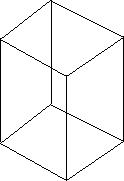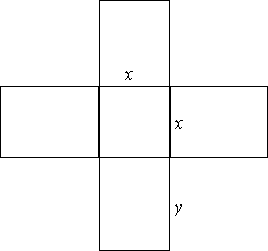Definitions
- Differentiation is finding the slope of a function
- Integration is finding the area described by the differential of a function
- Logic check:
- Integrating a differential must produce the original function
- Plus a constant, possibly
- The integration produces a whole class of functions considering the unknown added constant
- Differentiating an integral must produce the original differential
Types of Functions
| Case | Function Type | Example | Notes |
| Linear | $$x$$ | $$10^3$$ | |
| Polynomial | $$x^2, x^3, . . . x^n$$ | $$10^6, 10^9, ... 10^{3n}$$ | |
| Exponential | $$2^x, e^x, 10^x$$ | $$10^{300}, 10^{434}, 10^{1,000}$$ | |
| Factorial | $$x! , x^x$$ | $$10^{2,566}, 10^{3,000}$$ | $$x! = \dfrac{x^x}{e^x}$$ |
Simple Differentiation/Integration - The Power Rule
- $ \mbox{Function to differeniate is } f(x) = x^n $
- $ \dfrac{d}{dx}\left(x^n\right) = n x^{n-1} $
- $ \mbox{Example:} $
- $f(x) = x^5 $
- $\dfrac{d}{dx} f(x) = 5x^4 $
- $ \mbox{Function to integrate}= m x^{n-1} $
- $\int{m x^n}\,dx = \dfrac{m x^{n+1}}{n+1} + constant $
- $ \mbox{Example:}$
- $f(x) = 5 x^4$
- $\int{5x^4} = \dfrac{5x^{4+1}}{5} + constant =x^5 + constant $
Differention/Integration of two added functions
- $\mbox{Function to differentiate is } p(x) = a f(x) + b g(x) $
- $ \dfrac{dp}{dx} = a \dfrac{df}{dx} + b \dfrac{dg}{dx} $
- $\mbox{Function to integrate} = a \dfrac{df}{dx} + b \dfrac{dg}{dx} $
- $\mbox{Example:}$
- $f(x) = x^2 + x^3 $
- $\int(x^2 + x^3) \, dx = \int(x^2)\,dx + \int(x^3)\,dx = \dfrac{x^3}{3} + \dfrac{x^4}{4} $
Differentiation/Integration of two multiplied functions
- $ \mbox{Function to differeniate is } p(x) = f(x) g(x) $
- $ \dfrac{dp}{dx} = f(x) \dfrac{dg}{dx} + g(x) \dfrac{df}{dx} $
- $ \mbox {Example:}$
- $f(x) = x^5 sin{(x)}$
- $\dfrac{d}{dx} f(x)= 5x^4 sin{(x)} + x^5 cos{(x)} $
- $ \mbox{Function to integrate}= f(x) \dfrac{dg}{dx} + g(x) \dfrac{df}{dx} $
Differentiation/Integration of two divided functions
- $ \mbox{Function to differentiate is}\; p(x) = \dfrac{f(x)}{g(x)} $
- $ \dfrac{dp}{dx} = \dfrac{(g(x) \dfrac{df}{dx} - f(x) \dfrac{dg}{dx})}{g^2} $
Differentiation/Integration of nested functions
- $ \mbox{Function to differeniate is } p(x) = f(g(x))$
- $\mbox{so let }$
- $ y = g(x) $
- $ z = f(y) \\ $
- $ \dfrac{dz}{dx} = \dfrac{dz}{dy} * \dfrac{dy}{dx} $
- $ \mbox{Example:} \; f(x) = \sin(3x) $
- $ z = \sin(y) \; \mbox{and} \; y = 3x $
- $\dfrac{dz}{dx} = \cos(y) * 3 $
- $\mbox{Now substitute for y} $
- $\dfrac{dz}{dx} = 3 cos(3x) $
- $ \mbox{Function to integrate}= 3 cos(3x) $
Differentiation of Inverse Function
- $\mbox{If}\;y = f(x)\;\mbox{then}\; x = f^-1 (y) $
- $\mbox{Example:}$
- $\mbox{If the original function is}\; y = e^x$
- $\mbox{Then the inverse function is}\; x = \ln(y)$
- $\mbox{The relationship of the differentials of the original function and its inverse are:}$
- $\dfrac{dx}{dy} = \dfrac{1}{\dfrac{dy}{dx}} $
Fundamental Theorem of Calculus
- For a function f(x)
- Find a function F(x) whose derivative is f(x)
- Then while f(x) is positive
- $\int^B_A f(x) \, dx = F(x=B) - F(x=A) $
Table of Differentials & Integrals
| Differential | Function | Integral | Comments |
|---|---|---|---|
| $$n x^{n-1} $$ | $${x^n}$$ | $$\left(\dfrac{x^{n+1}}{n+1}\right) + C$$ | $$n \ne -1 $$ |
| $$\dfrac{1}{x}$$ | $$\ln{x}$$ | $$(x \ln{x}) - x $$ | |
| $$ce^{cx}$$ | $${e^{cx}}$$ | $$\dfrac{e^{cx}}{c}$$ | |
| $$\cos{x}$$ | $${\sin{x}} $$ | $$-\cos{x} $$ | |
| $$-\sin{x}$$ | $${\cos{x}} $$ | $$\sin{x} $$ | |
| $${\tan{x}} $$ | $$\ln{\sec{x}} $$ | ||
| $${\csc{x}} $$ | $$-\ln{(\csc{x} + \tan{x})} $$ | ||
| $${\csc} $$ | $$\ln\tan\dfrac{x}{2} $$ | ||
| $${} $$ | $$ $$ |
Examples of practical uses of Differentiation
- Note:
- The first derivative when set to zero calculates a minimum or a maximum or both.
- The second derivative tells us how the first derivative changes.
- If it is always less than zero, then the results from the first derivative = 0 calculations is a maximum.
- If it is always greater than zero, then the results from the first derivative = 0 calculations is a minimum.
- Example:
- $y = x^2 \; \mbox{is a parabola with a minimum at x = 0.}$
- $\dfrac{d(x^2)}{dx} = \dot{x^2} = 2 x $
- $ 2x = 0 \therefore x = 0 \; \mbox{is a min or a max.} $
- $ \dot{2 x} = \ddot{x^2} = 2 \; \mbox{thus x = 0 is a min, i.e. all changes to slope go up} $
- A
rectangular storage area is to be constructed along the side of a
tall building. A security fence is required along the remaining 3
sides of the area. What is the maximum area that can be enclosed
with
800 m of fencing?

The area isA=xy
We know2x+y=800 soy=800−2x
So the area is A = x(800 − 2x) = 800x − 2x2
To maximise the area, find whendAdx=0
whendAdx=800−4x=0
Is it a maximum?x=200
So it is a maximum.d2Adx2=−4<0 for all x
So the maximum area occurs whenx=200 ,y=400 and that area is:
A = 200 × 400 = 80 000 m2 - A box
with a square base has no top. If 64 cm2 of material is used, what is the maximum possible volume for the
box?

The net for this box would be:

The volume of the box is V = x2y
We are told that the surface area of the box is 64 cm2. The area of the base of the box is x2 and the area of each side is xy, so the area of the base plus the area of the 4 sides is given by:
x2 + 4xy = 64 cm2
Solving for y gives:
So the volume can be rewritten:y=64−x24x=16x−x4
NowV=x2y=x2(16x−x4)=16x−x34
and this is zero whendVdx=16−3x24
(Note: The negative case has no practical meaning.)x=±83√≈4.62
Is it a maximum?
and this is negative when x is positive. So it is a MAX.d2Vdx2=−3x2
So the dimensions of the box are:
Base 4.62 cm × 4.62 cm and sides 2.31 cm.
The maximum possible volume is
V = 4.62 × 4.62 × 2.31 ≈ 49.3 cm3
Check: Area of material:
x2 + 4xy = 21.3 + 4 × 4.62 × 2.31 = 64
Checks OK.
Examples of practical uses of Integration
- $\mbox{The circumfrence of a circle} = 2 \pi r $
- $\mbox{So the area of a circle} = \int(2 \pi r)\,dr = \pi r^2 $
- $\mbox{The surface area of a sphere} = 4 \pi r^2 $
- $\mbox{So the volume of a sphere} = \int(4 \pi r^2)\,dr = \dfrac{4}{3}\pi r^3 $
No comments:
Post a Comment